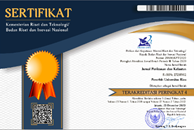Development of Artificial Live Rock in Supporting Ornamental Coral Cultivation Activities
(1) Prodi Akuakultur Fakultas Matematika dan Ilmu Pengetahuan Alam, Universitas Pendidikan Ganesha
(2) Prodi Akuakultur Fakultas Matematika dan Ilmu Pengetahuan Alam, Universitas Pendidikan Ganesha
(3) Prodi Akuakultur Fakultas Matematika dan Ilmu Pengetahuan Alam, Universitas Pendidikan Ganesha
(*) Corresponding Author
Abstract
Keywords
Full Text:
PDFReferences
Adi, I. N.D., Damar, A., Adrianto, L., Soedharma, D., Kusumastanto, T., & Rikardi, N. (2016). Growth of some of Transplanted Coral Genus and Fish Community Developed at Two Different Transplantation Sites in Kepulauan Seribu, DKI Jakarta, Indonesia. International Journal of Science: Basic and Applied Research, 29(3), 36–52.
Adi, W., Komarullah, U., Sanjaya, H., Ardyansah, R., & Gunawan, R. (2020). Kondisi Terumbu Karang di Pulau Gelasa Kabupaten Bangka Tengah The Coral Reef Condition of Gelasa Island, Central Bangka Regency. Journal of Tropical Maurine Sciences, 14(2019): 13–19. https://doi.org/10.33019/jour.trop.mar.sci.v2i1.909
Ampou, E.E., Setiabudi, G.I., & Widagti, N. (2020). Coral diversity on artificial reef from coconut shells in northern Bali, Indonesia. Biodiversitas Journal of Biological Diversity, 21(9), 4331–4338. https://doi.org/10.13057/biodiv/d210952
Faizer, A., & Adi, W. (2016). Perbandingan ikan pada padang lamun buatan dan terumbu karang buatan di Pantai Turun Aban Sungailiat , Kabupaten Bangka Comparison of Fish between Artificial Seagrass and Artificial Reefs in Turun Aban Beach Sungailiat , Regency of Bangka. Journal of Aquatropica Asia, 3(1), 29–34.
Farid, M., Purnomo, P.W., & Supriharyono, S. (2018). Perubahan Tutupan Terumbu Karang Ditinjau Dari Banyaknya Wisatawan Di Tanjung Gelam Kepulauan Karimunjawa Menggunakan Citra Satelit Landsat 8 Oli. Management of Aquatic Resources Journal (MAQUARES), 7(1), 18–27. https://doi.org/10.14710/marj.v7i1.22521
Giyanto, Abrar, M., Hadi, T. A., Budiyanto, A., Muhammad Hafizt, Salatalohy, A., & Iswari, M. Y. (2017). Status Terumbu Karang di Indonesia 2017. Lembaga Ilmu Pengetahuan Indonesia.
Hamizan, M.Y., Shahbudin, S., Hadry, N.F., Mahfuzah, Y., Rafindde, R., Akmal, M.F.K., & Husaini, M.R. (2015). The potential of artificial live rock as subtrate for coral spat and epibenthic organisms. Jurnal Teknologi, 77(25), 25–29. https://doi.org/10.11113/jt.v77.6732
Idris, Zamani, N. P., Suharsono, & Fakhrurrozi. (2020). Coral reef degradation due to ship grounding in indonesia: Case study of ship aground in bangka-belitung waters by mother vessel mv lyric poet. Jurnal Ilmiah Perikanan dan Kelautan, 12(2), 263–275.
Kasmi, M., Asriany, Makkulawu, A.R., Usman, A.F. (2020). Peningkatan pengelolaan budidaya karang hias lestari berbasis masyarakat. Jurnal Balireso: Jurnal Pengabdian pada Masyarakat 5(2), 109–123. https://doi.org/10.33096/balireso.v5i2.164
Lalang, L., Zamani, N.P., & Arman, A. (2015). Perbedaan Laju Pertumbuhan Karang Porites lutea di Pulau Tunda. Jurnal Teknologi Perikanan dan Kelautan, 5(2): 111–116.
Li, Y., Zheng, X., Yang, X., Ou, D., Lin, R., & Liu, X. (2017). Effects of live rock on removal of dissolved inorganic nitrogen in coral aquaria. Acta Oceanologica Sinica, 36(12), 87–94.
Muzaki, F. K., Hanifa, R., Akhwady, R., & Saptarini, D. (2019). Short Communication : Growth rate of Acropora muricata coral fragments transplanted on dome-shaped concrete artificial reef with different composition. Biodiversitas Journal of Biological Diversity, 20(6), 1555–1559. https://doi.org/10.13057/biodiv/d200610.
Setiawan, F., Muttaqin, A., Tarigan S.A., Muhidin, Hitmariyah, Sabil, A., Pinkan, J. (2017). Dampak pemutihan karang tahun 2016 terhadap ekosistem terumbu karang : studi kasus di TWP Gili Matra (Gili Air, Gili Meno dan Gili Trawangan) Provinsi NTB. Jurnal Kelautan, 10(2): 147-161. https://doi.org/10.21107/jk.v10i2.2878
Article Metrics
Abstract view : 184 timesPDF - 181 times
DOI: http://dx.doi.org/10.31258/jpk.27.3.272-279
Copyright (c) 2022 Imam Safii

This work is licensed under a Creative Commons Attribution-NonCommercial-NoDerivatives 4.0 International License.
Gedung Marine Center Lt 2. Fakultas Perikanan dan Kelautan Universitas Riau



